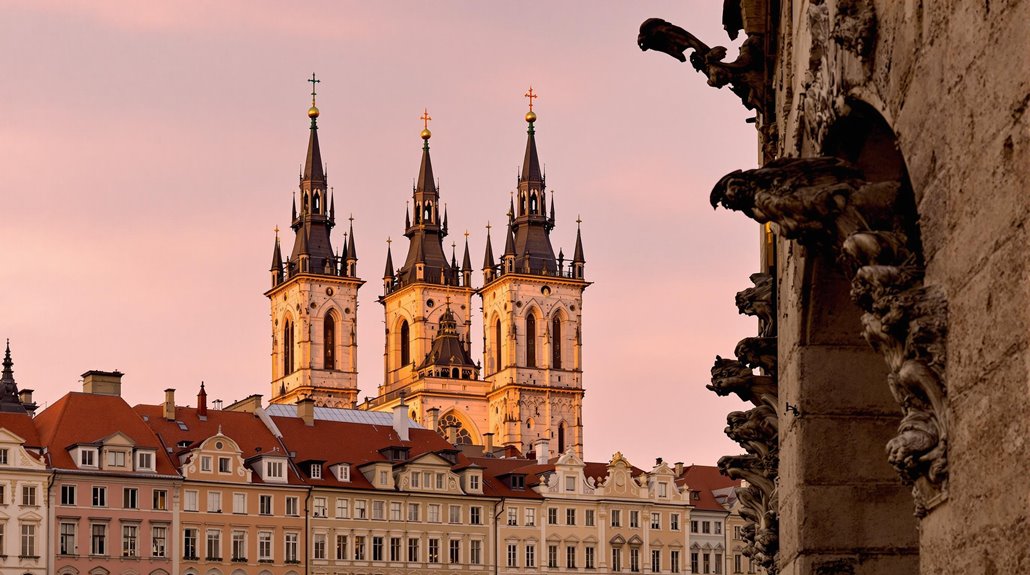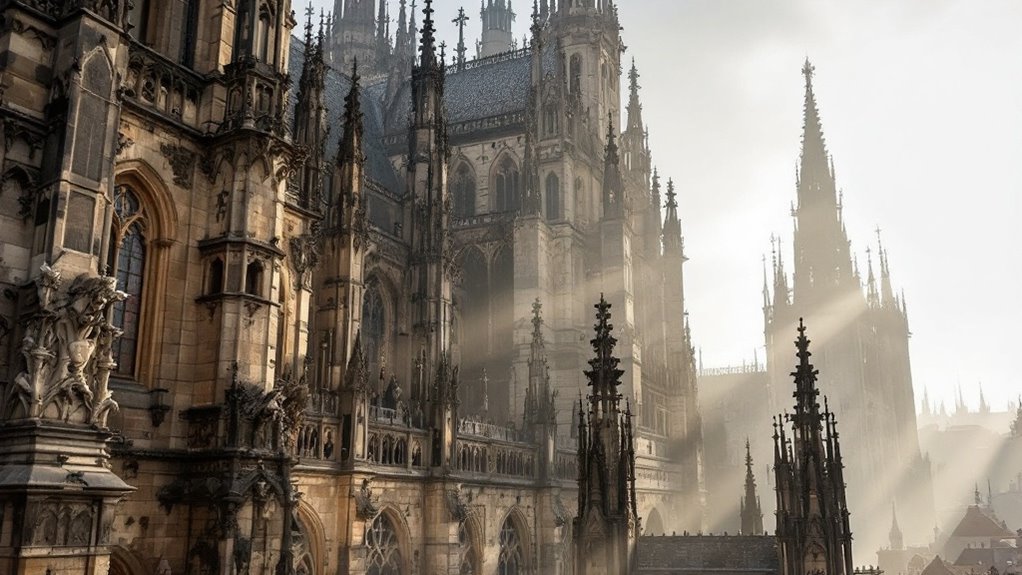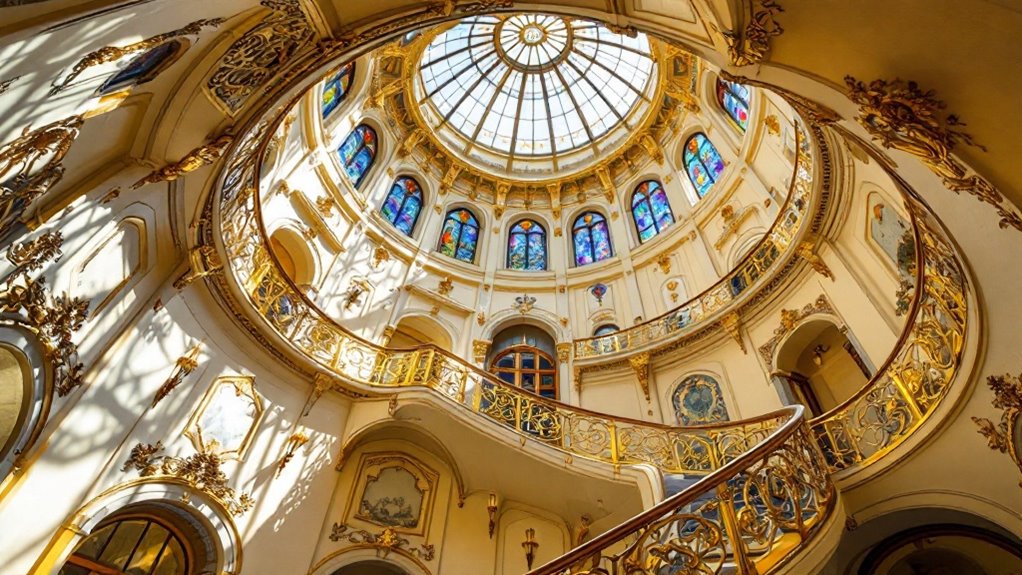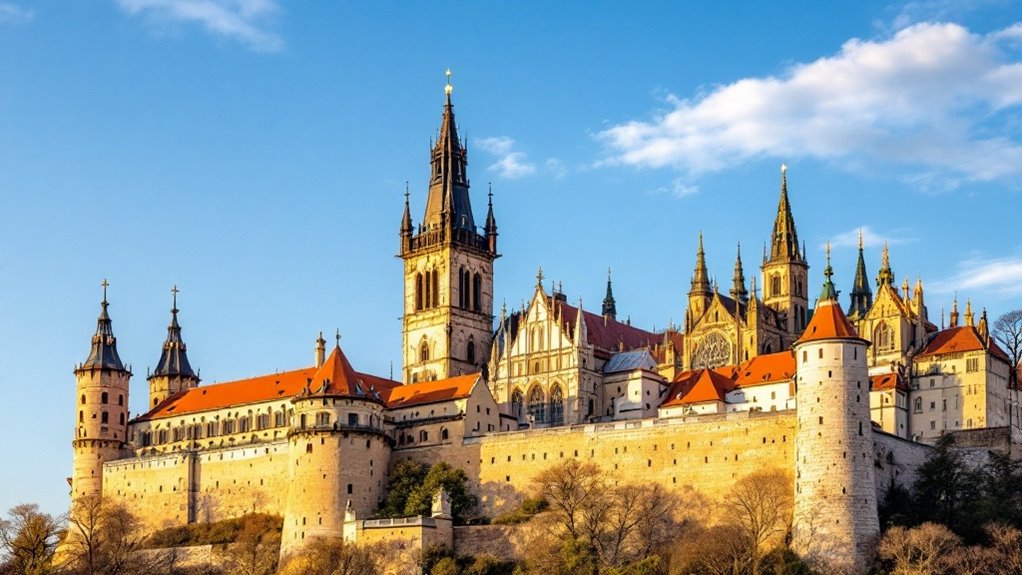Physical Address
304 North Cardinal St.
Dorchester Center, MA 02124
Physical Address
304 North Cardinal St.
Dorchester Center, MA 02124

You will discover Prague's architectural heritage is more accessible than you might think. The city's most remarkable structures don't require expensive tours or exclusive access – just a good pair of walking shoes and a basic map. From Gothic spires to Dancing Houses, these five architectural landmarks showcase Prague's evolution across centuries. Let's explore how you can experience these iconic sites while keeping your wallet intact.

As you explore Prague's medieval heritage, the city's Gothic architecture stands as a tribute to its golden age under Charles IV in the 14th century.
You'll discover the most impressive example at St. Vitus Cathedral, where Petr Parler's innovative net vaults and stunning stained glass windows showcase medieval engineering at its finest. Work on the cathedral was halted in 1419 during Hussite Wars.
Don't miss the iconic Charles Bridge, guarded by three Gothic towers, or the Church of Our Lady Before Týn, whose 80-meter twin spires dominate Old Town Square.
Twin Gothic spires pierce Prague's skyline while medieval towers stand sentinel over Charles Bridge, creating an unforgettable medieval panorama.
The Old Town Hall, though partially destroyed in 1945, still houses the famous Astronomical Clock.
These structures feature classic Gothic elements like ribbed vaults, tall narrow windows, and flying buttresses that enabled builders to create increasingly taller buildings.
You'll see why Prague became a central hub for Gothic architectural innovation in medieval Europe.
Three magnificent examples of Prague's Baroque splendor await you along the Vltava River: St. Nicholas Church, Charles Bridge, and Wallenstein Palace.
At St. Nicholas, you'll discover an 80m dome adorned with Kracker's frescoes and a bell tower offering city views. Don't miss the gilded interior with its dramatic sculptures and faux marble work. The church stands as a testament to High Baroque elements with its impressive architectural details and ornate design.
Cross Charles Bridge to admire 30 Baroque statues, including the famous St. John of Nepomuk monument. While the originals are now in museums, the replicas still capture the dramatic motion of Braun and Brokoff's craftsmanship.
Make your way to Wallenstein Palace, where you can explore the free weekend tours and stroll through geometric gardens featuring mythological sculptures.
For book lovers, the nearby Klementinum's Baroque library showcases celestial frescoes and 20,000 historical volumes.

While Baroque grandeur dominates Prague's riverside, the city center showcases stunning Art Nouveau treasures from the early 1900s.
You'll discover the finest example at the Municipal House (Obecni Dum), built between 1905-1912, featuring ornate mosaics and stained glass.
The elegant Hotel Pariz stands nearby, adorned with sculptural lamps and mosaic details since 1904.
Dating to 1904, the graceful Hotel Pariz captivates visitors with its sculptural lighting and intricate mosaic embellishments.
Don't miss the Praha Insurance Building with its Czech inscriptions and Art Nouveau motifs, or the adjacent Topic House's floral wreaths.
Thanks to European Union subsidies, many building owners were able to restore these architectural masterpieces to their former glory after years of Communist-era neglect.
The František Palacký Monument, revealed in 1912, combines bronze and granite in true Art Nouveau style.
Prague's remarkable architectural marvels represent some of the most significant landmarks in Eastern Europe.
For a grand finale, visit the Lucerna Palace complex near Wenceslas Square, where modern art meets historical architecture in an unexpected twist.
Prague's modern architectural landscape explodes with innovation through four distinct movements: Deconstructivism, Czech Cubism, Functionalism, and Brutalism.
You'll discover these groundbreaking structures throughout the city, from Gehry's undulating Dancing House to Hadid's gilded Masaryčka Building. The House of the Black Madonna stands as a representation of Czech Cubism, while Villa Müller showcases Functionalist principles. Serving as a towering architectural landmark, the tower reaches 216 meters into the sky, making it Prague's tallest structure.
For the best modern architectural experiences, don't miss:
These landmarks prove Prague isn't stuck in the past, with bold designs challenging traditional aesthetics while remaining accessible to everyday visitors.

Beyond the modern marvels, the heart of Prague's architectural legacy beats within its royal landmarks and defensive walls.
You'll discover the sprawling Prague Castle Complex, spanning 45 hectares, where Czech rulers have governed since the 9th century. At its core stands St. Vitus Cathedral, where you can climb 287 steps for city views and marvel at Mucha's stained glass.
The iconic Old Town Square has served as the city's central gathering place since the 12th century, attracting visitors with its mix of Gothic and Baroque architecture.
Don't miss Vyšehrad Fortress, perched above the Vltava River, with its free-to-explore grounds and the stunning Church of Sts. Peter and Paul.
The city's medieval fortifications tell their own story – from the mighty Hunger Wall on Petřín Hill to the restored Baroque Bastion at Calvary.
For a glimpse of Renaissance grandeur, head to the Old Royal Palace's Vladislav Hall, featuring Europe's largest secular Gothic vaulted ceiling.
You will discover Prague's architectural heritage offers incredible value for your travel budget. From free walking tours around Gothic churches to affordable entry fees at the Municipal House, you can experience centuries of design without breaking the bank. Don't miss the exterior views of the Dancing House and Charles Bridge at sunset – they're completely free and perfect for amazing photos you'll treasure forever.